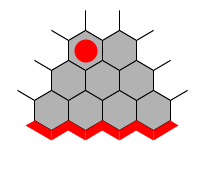Difference between revisions of "Edge template"
From HexWiki
m (added paragraph break after definition) |
|||
| Line 3: | Line 3: | ||
Here is an example of a [[Third row|third-row]] edge template ([[template IIIa]], also known as the ''Ziggurat''): | Here is an example of a [[Third row|third-row]] edge template ([[template IIIa]], also known as the ''Ziggurat''): | ||
| − | + | [[Image:Ziggurat.png]] | |
| − | The [[Hex (board element)|cells]] marked by a star are irrelevant to the template, and can be occupied by either [[player]], or can be [[Empty hex|empty]]. Even if [[Blue (player)|Blue]] moves first, there is no way he can prevent from connecting to the [[bottom edge|bottom]]. | + | <!-- <hex>R3 C4 Vc1 Sa1 Sb1 Sa2</hex> --> |
| + | |||
| + | The red stone has a certain connection to the bottom, using only the shaded hexagons, even if blue moves first. | ||
| + | |||
| + | <!-- The [[Hex (board element)|cells]] marked by a star are irrelevant to the template, and can be occupied by either [[player]], or can be [[Empty hex|empty]]. Even if [[Blue (player)|Blue]] moves first, there is no way he can prevent from connecting to the [[bottom edge|bottom]]. --> | ||
Countless edge templates can be constructed, all of them of varying degrees of usefulness and frequency of occurance. | Countless edge templates can be constructed, all of them of varying degrees of usefulness and frequency of occurance. | ||
Revision as of 11:13, 28 March 2005
An edge template is a pattern which guarantees a connection the edge.
Here is an example of a third-row edge template (template IIIa, also known as the Ziggurat):
The red stone has a certain connection to the bottom, using only the shaded hexagons, even if blue moves first.
Countless edge templates can be constructed, all of them of varying degrees of usefulness and frequency of occurance.
